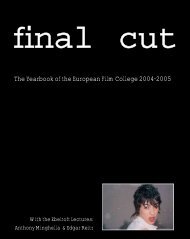yearbook 2004/05 - The European Film College
yearbook 2004/05 - The European Film College
yearbook 2004/05 - The European Film College
Create successful ePaper yourself
Turn your PDF publications into a flip-book with our unique Google optimized e-Paper software.
to recover its image as an art form,<br />
rather its standard and quality have<br />
been gradually deteriorating. It is<br />
said that contemporary cinema only<br />
meets the taste of a section of the<br />
people. <strong>The</strong> audiences who still go to<br />
cinema halls tend to be less educated<br />
and belong to the low-income group<br />
i.e. the working class people of the<br />
society. It fits with the notion of Jane<br />
Adams who termed the movie theatre<br />
a ‘Dream Palace’ where the urban<br />
working class might get the scope to<br />
perpetuate their dream.2 But this is<br />
not the entire reason for this<br />
change in demographic of<br />
the cinema audience. We saw<br />
a tremendous technological<br />
boom in the media and communication<br />
sphere in last<br />
two decades. As the middle<br />
class are economically well<br />
off, they also have access to alternative forms<br />
of entertainment, VCR, cable<br />
TV, VCD/DVD and the<br />
Internet, which have brought<br />
them much wider options.<br />
Big budget Hollywood films,<br />
the Mumbai glamour world,<br />
the vastness of cyberspace<br />
with chat rooms and various<br />
pornographic options can be<br />
found as well as newly released<br />
Bangla cinema, which is also easily accessible<br />
through those new technologies. So the state<br />
of audience at the cinema halls in Bangladesh<br />
has been found to be one in a state of change.<br />
Before going on to review the film audience in<br />
Bangladesh it could be relevant to discuss the<br />
concept of “audience” itself.<br />
Audience: <strong>The</strong> concept<br />
Actually the concept of ‘audience’ had not registered<br />
among the media scholars as a culturally<br />
significant one until 1980s. 3 For the first<br />
FROM THE STUDENTS<br />
time, Denis McQuail drew the attention<br />
regarding media audience in 1983 in his<br />
book Mass Communication <strong>The</strong>ory. 4 He<br />
found that the media audience was an important<br />
entity and defined the audience<br />
as an aggregate of spectators, readers, listeners<br />
and viewers. He also termed the audience<br />
as ‘mass’, ‘public or social group’ and ‘market’.<br />
In postmodern a approach, the reader (movie<br />
viewer) is the prime concern, text (movie) and<br />
author (director of the movie) is less important.<br />
<strong>The</strong>refore more attention is supposed to be paid<br />
to the audience in the contemporary cine-world<br />
although the producers, artists, distributors and<br />
the audience cohere together in the process of<br />
filmmaking and projection. <strong>The</strong>y control each<br />
other as Jarvie (1970: 42) says:
















